The core and important device in audio "decoder" is nothing more than a "DAC" (digital-to-analog conversion) chip.People often pay close attention to the selection of audio DAC chips and are keen to discuss its advantages and disadvantages.
This paper attempts to briefly introduce the structure, technology and performance of the best high-end audio DAC chips, and make a ranking for your reference.
Nevertheless, any high-quality audio DAC chip (regardless of ranking) may be used to achieve a good sound of the whole machine. Presumably, we should not only objectively understand the importance of the DAC chip, but also objectively understand the importance of the overall cooperation of the chip. Therefore, this article does not advocate Only "core" doctrine.
1
Types of audio DAC chips
In the 1970s, DAC began to have monolithic integrated circuits (IC), even if it ushered in the chip age of DAC. The earliest DAC chips started with the technology of bipolar transistors using weighted resistors.
DAC chip DAC08, 8 bit in 1975, from The Data Conversion Handbook, ANALOG DEVICES, 2005
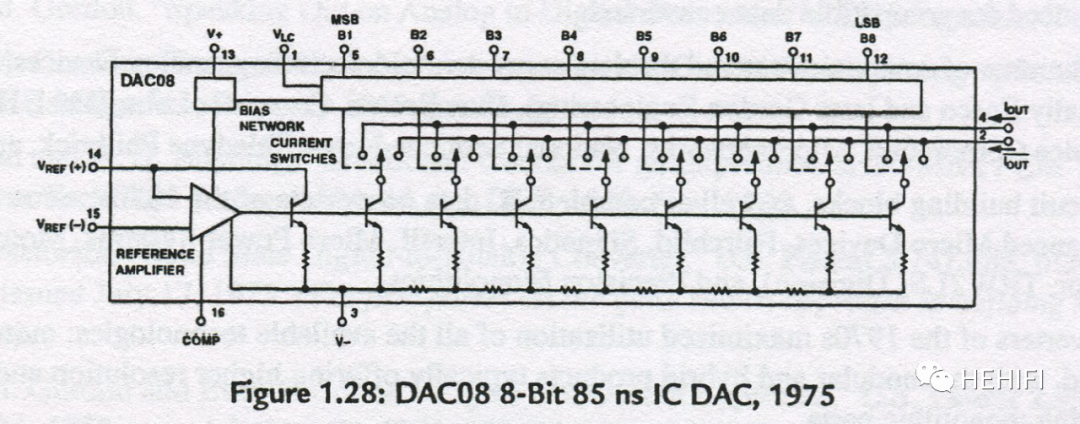
1) voltage-tapping type
In audio applications, the traditional technology is to use voltage division structure (R2R is a special case of voltage division), multi-bit (parallel input) PCM (pulse code modulation) data format, in order to improve accuracy and speed, reduce power consumption, the process gradually uses complementary bipolar collective transistor, thin film resistance plus laser correction and the current CMOS circuit. Among these chips, there are several famous chips such as Burr-Brown (acquired by Texas Instruments in 2000) R2R structure:
PCM63:Support for 20 bit / 96kHz PCM audio signal, dynamic range 108dB
PCM1702:Launched in 1995, 20-bit, dynamic range 110dB
PCM1704:Launched in 1999, 24-bit, dynamic range 112dB.
These chips have adopted some special measures to improve their performance, such as using the "symbol magnitude (sign-magnitude)" architecture to reduce zero-crossing distortion and differential errors by using small differential DAC circuits near zero, complementary two sets of DAC circuits to generate absolute current, laser corrected resistors and so on.
R2R DAC chip PCM1704Excerpt from PCM1704 24-Bit, Datasheet, Burr-Brown Corporation, February, 1999

Philips Semiconductor (merged with Motorola Semiconductor in 2006 to form NXP Semiconductor) has also introduced digital stream (serial input) DAC chips such as:
TDA1541/TDA1541A:16-bit, introduced in 1985 and 1991 respectively, signal-to-noise ratio 95dB and 110dB, using 10-bit + 6-bit voltage divider, of which the low 6-bit uses 3 2-bit rotation to achieve dynamic element adaptation (DEM) function to reduce distortionTDA1541A is linear by differenceThe error is divided into / N2/R1, / N2 and / N2/S1 levels from high to low.
TDA1547:Introduced in 1991, 1-bit (support 20-bit PCM signal), signal-to-noise ratio 113dB, dynamic range 108dB, need to be used in conjunction with SAA7350 digital flow circuit. The layout of the separation chip and the independent channel design have a good channel separation (115dB). The digital-to-analog conversion is carried out by switching the capacitor partial voltage network, which is very suitable for high-end CD players at that time.
TDA1547 block diagram of digital stream DAC chipExtracted from "TDA1547 Datasheet" Philips Semiconductors, September 1991
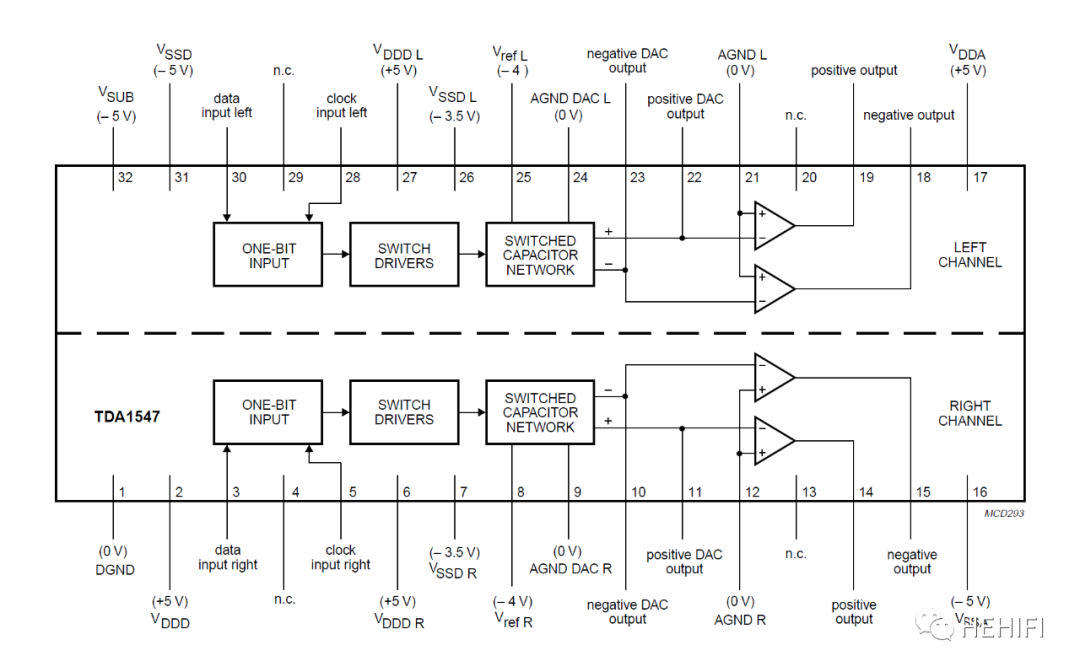
2) Sigma-Delta
Better performance (larger dynamic range, less noise and distortion) and more audio DAC chips using multi-bit Sigma-Delta modulators. Famous ones are as follows:
Analog Devices (AD), Inc.AD1955,Cirrus Logic (CL), Inc.CS43xxseries,British Wolfson Semiconductor (acquired by Cirrus Logic in 2014)WM87xxseries,Texas Instruments (TI), Inc.PCM179xAndDSD179xseries,Under the SABRE SOUND technology brand of ESS Company of the United StatesES90xxAndES90xxPROseries,DayThis Asahi Kasei Microdevices (AKM) company, the world's first 32-bit in 2007AK4397, and then under the VELVET SOUND technology brandAK44xxseries,Wait.
Right now, ESS,AKM、Cirrus Logic 、 Texas InstrumentAnd other companies are the main suppliers of high-end audio DAC chips.
3) FPGA/CPLD
With the progress of chip technology, there are more choices to realize the function of DAC. FPGA (Field Programmable Gate Array) or CPLD (complex Programmable Logic device) can be used to realize the function of DAC according to the needs of designers. The main manufacturers of such devices are Xilinx and Intel (acquired Altera) companies in the United States.
Mainstream chip
Due to the limitation of technology, it is very difficult to improve the performance of R2R DAC chip. The technical details of FPGA or CPLD to achieve DAC are not unified. Because of the advantages of large dynamic range, low noise, low cost of CMOS circuit and easy to add other processing functions on the chip, the chip using Sigma-Delta technology is the mainstream chip in the audio market and high-end audio market at present.
2
Chip composition
The audio DAC chip is mainly composed of the following forms:
1) basic DAC
The most basic functional component of audio DAC chip is a multiplexer to receive various formats of audio signals (DSD or PCM), oversampling and digital filter, modulator and digital-to-analog conversion output. AKM Inc.AK4499、AK4497And Texas Instruments.DSD1794The chip is constructed like this, as shown in the following figure:
Basic DAC chip composition

Such chips need to be used in conjunction with external digital audio receiver chips to receive serial audio data under standards such as SPDIF (Sony Philips Digital Interface or Sony Philips Digital Interconnection format) / AES (American Association of Acoustic Engineering) / EBU (European Broadcasting Union). Cirrus Logic Inc.CS8416It is a typical digital audio receiver chip.
Figures Audio receiver chip CS8416 block diagram, extracted from "CS8416 Datasheet", Cirrus Logic, Inc. AUGUST'07.
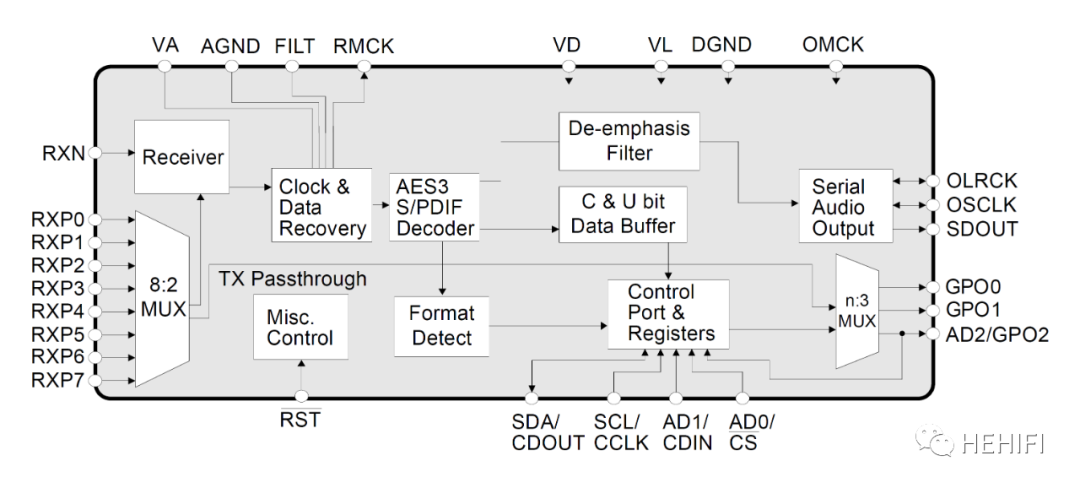
2) With Digital Audio Receiver
Some chips integrate digital audio receivers into the same DAC chip, such as ESSES9038PRO、ES9028PROAnd so on, a SPDIF function block is integrated. In this way, the benefits of adopting a higher degree of SoC (solution on Chip) design idea can not only reduce the number of chips, reduce the occupied area of circuit boards, reduce external interference, reduce power consumption, etc., more importantly, it can be more convenient to carry out data processing to achieve some technical means.
DAC chip with SPDIF receiver

Comparison of SPDIF Digital Audio receiver Settings

3) independent modulation and independent digital to analog conversion
Chips such as AKM, which are not yet on the market.AK4191Is an independent bit modulator that supports DSD1024 and PCM signals with sampling frequencies up to 1536kHz, andAK4498The combination of independent digital-to-analog conversion chips can achieve high-density audio playback.
4) solution on Chip (SoC)
Chips such as Cirrus Logic'sCS43131、CS43198And so on, after the basic DAC function block, there is an analog filter, which can output the analog signal directly, such as ESS'sES9219、ES9080, AKM'sAK4377AEtc., with a high-power analog amplifier, which can be directly connected to the headset; such as ESS'sES9038Q2MAnd so on, low power consumption design is adopted. SoC design simplifies the composition and materials of the whole machine, reduces the volume and reduces the cost. These chips are application-oriented, such as for mobile phones or mobile devices.
3
Technical means
At present, almost all high-end audio DAC chips use multi-bit Sigma-Delta modulators with good performance, such as oversampling and digital filtering, noise shaping, dynamic element adaptation (DEM) and so on. In addition, various manufacturers have also developed their own technologies to further improve the overall performance of the chip.
1)Asynchronous sampling rate conversion (ASRC)Technical
Conventional chips track audio clocks by using PLL (Phase locked Loop) technology. The following figure shows a typical schematic diagram of the PLL circuit. PLL is essentially a feedback circuit used to track the clock and changes of the input signal.
Conventional PLL circuit schematic diagram, extracted from "CS8416 Datasheet", Cirrus Logic, Inc. AUGUST'07.

Through careful design and selection of components, PLL can achieve good clock tracking performance and control Jitter (time base jitter) at a small level. However, the performance of PLL circuit is easily affected by signal quality, transmission line quality, equipment, interference and speed, and its performance is limited at high speed.
ESS uses asynchronous sampling rate conversion technology. Through proper calculation, the DAC clock is consistent with the audio signal clock but separated from the transient change. The chip uses locally generated clock signals, and the Jitter of DAC only depends on the inherent performance of the local crystal oscillator.To substantially eliminate Jitter in signal neutralization and transmissionTo reduce the requirements for front-end signal quality, connecting lines, equipment, etc. ESS Sabre DAC's SPDIF interface can achieve a very generous Jitter tolerance.
Sabre DAC'sJitterElimination circuit schematic diagram, extracted from "About Jitter" AMM ESS, October 2011
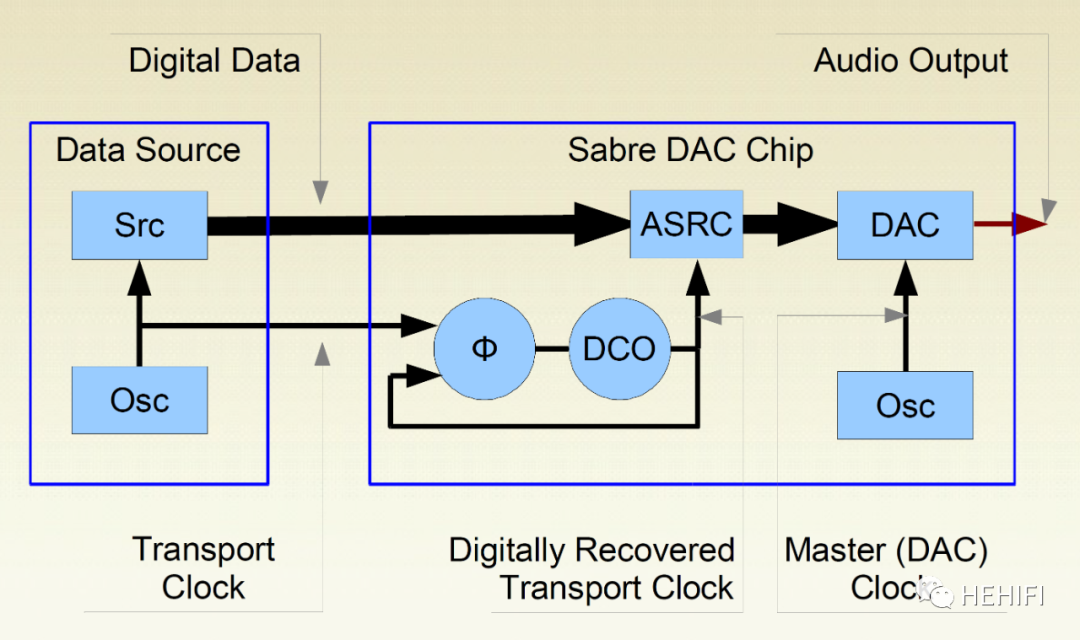
Comparison of different clock sources of chips

2) HyperStream modulator
ESS's low-cascade modulator, calledHyperStreamThe modulator makes the modulation depth close to 100% and keeps the modulator stable, thereby reducing the transient (frequency domain) nonlinearity and noise of the Sigma-Delta DAC.
3) oversampling rate multiplier(OSR Doubler)
Sigma-Delta DAC uses oversampling technology to expand the dynamic range, and then uses noise shaping to reduce the noise in the audio band. The oversampling frequency of the early DAC chip is still at a low level, such as 416 times the standard audio sampling frequency, the current chip can achieve a higher frequency to further improve the performance of DAC. AKM, Japan, uses oversampling rate multiplier (OSR Doubler) in digital filtering to increase the range of input signals, reduce in-band noise and reduce power consumption. Its high-end DAC chips such asAK4490And so on, the oversampling multiple can reach 256 times.
4) segmented DAC
According to the different position and function, the segmented digital signal is high and low, and then processed purposefully, the performance of DAC can be improved. Texas Instruments inPCM179xAndDSD179xSeries and other chips use this technology, called "advanced segmented DAC", to increase the dynamic range and improve the tolerance to Jitter.
Texas Instruments's "Advanced Segmentation DAC" schematic, extracted from "DSD1794A Datasheet" Texas Instruments, NOVEMBER 2006

5) other technologies
In order to improve as much as possibleAudio DACThe performance of the chip will also be adopted by the manufacturerOther technologies, such as:Data weighted average(DWA)、Gain correction andDistortion compensation、Reference voltage correction, current output, low output impedance, differential complementary output, external digital filter, low noise linear power supplyOh, wait a minute.The technical means are diverse, and some technologies are still kept secret, so it is difficult to list and describe them one by one.
4
Ranking of high-end audio DAC chips
Dynamic range is a representative performance parameter of audio DAC. According to this performance and other factors, the highest-end audio DAC chips are ranked below.
Ranking of high-end audio DAC chips:
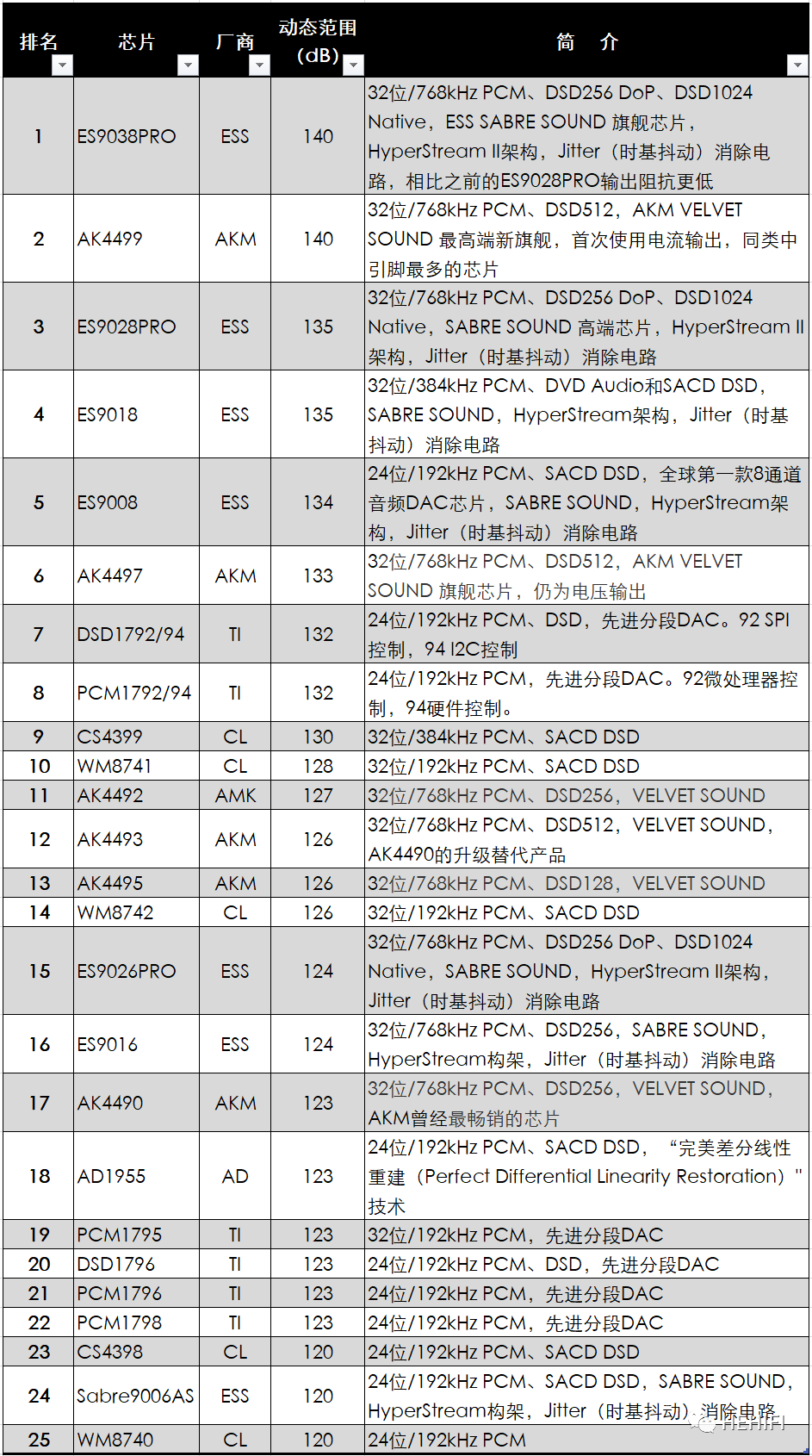
Note:The dynamic range data is the maximum value of each corresponding chip published by each manufacturer. Not rankedIncludeApplication-oriented (such as analog amplifier SoC), independent modulator, independent digital-to-analog converterAndDiscontinued productionEtc.Chip.
ESS Inc.ES9038PROAs one of the chips with the highest parameter index in the industry so far, the SPDIF interface is integrated on the chip. Through the Jitter elimination circuit using the sampling rate asynchronous conversion technology, it is decoupled from the front-end transmission Jitter and has a large Jitter tolerance. The HyperStream patented modulator can enable the Sigma-Delta modulator to overcome some very linear transients in the frequency domain, plus some other technologies. Such as distortion correction, 8-channel switchable differential DAC, dedicated ultra-low noise linear power supply (ES9311Q), etc., as the best performance chip, there are many advantages.
ESS flagship chip ES9038PRO block diagram, extracted from "SABRE PRO ES9038PRO Datasheet", ESS March 5, 2019

AK4499AKM's new flagship, the chip with the largest number of pins and the most expensive chip in the array, has the highest dynamic range in the industry (on a par with ES9038PRO), but it does not have a SPDIF interface, so if considered under the same conditions, the comprehensive performance index should be slightly lower than that of a single chip. In addition, AK4499 is 4-channel DAC, which is less than ES9038PRO; 's support for DSD, up to DSD512, and also lower than ES9038PRO's DSD1024.
AK4499, the new flagship chip of AKM with the largest number of pins, from "AK4499 Premium Switched Resistor 4ch DAC", AsahiKASEI, 2019 Universe 02
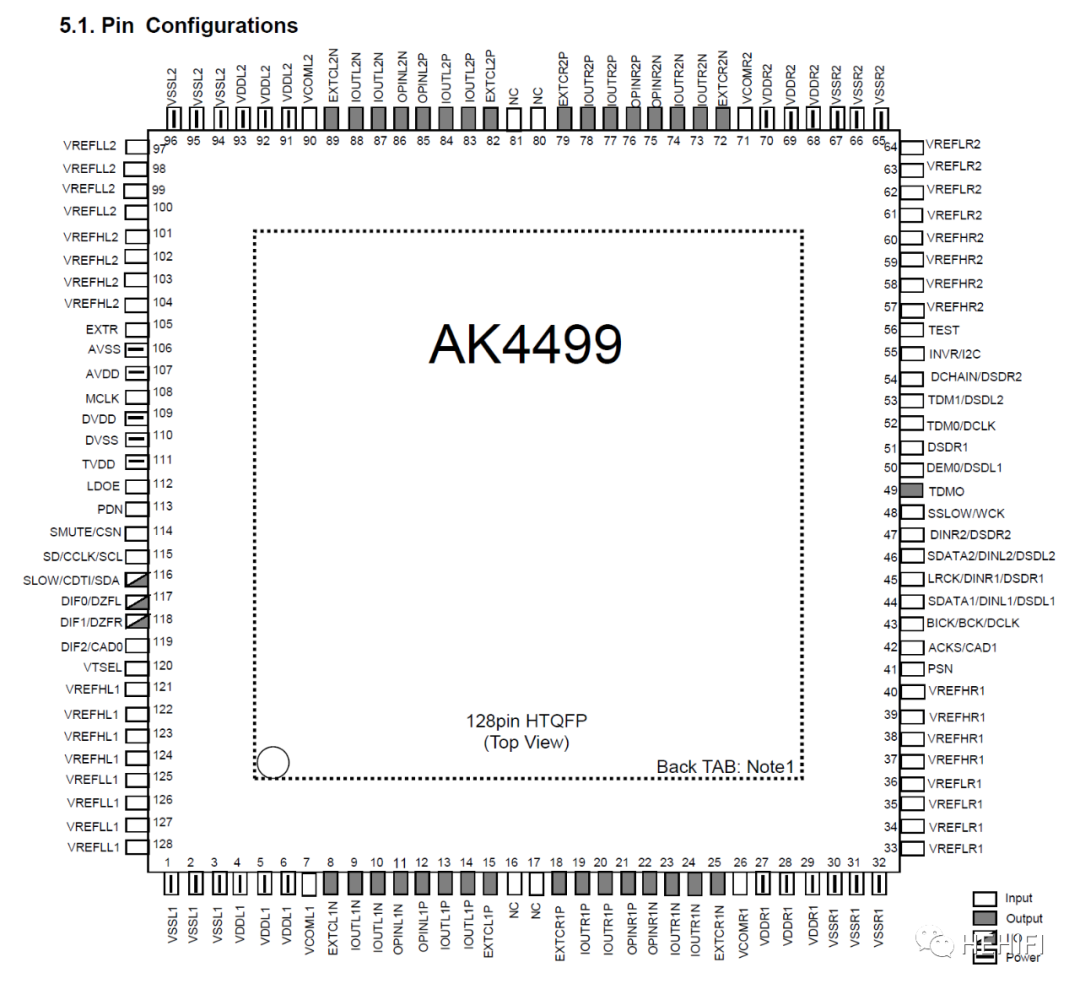
ES9028PRO,The chip which is almost exactly the same as ES9038PRO (including function and chip packaging, pins) can only be found in two places: one is that the output impedance is greater than ES9038PRO;, and the other is that the index of dynamic range, distortion and noise is lower than that of ES9038PRO. There is no basis for whether the comprehensive index will be higher than the AK4499 (adding SPDIF interface, etc.) under the same conditions, which is slightly inferior to the flagship chip.
ES9008、ES9018, too.32-bit, 8-channel chipAsynchronous sampling rate conversion and other technologies are also used, which are the chips with the highest performance at that time, but the chips launched earlier under the SABRE SOUND brand of ESS also use the earlier HyperStream modulation technology, and their comprehensive performance is lower than that of ES9028PRO.
AK4497AKM is the last flagship chip, a famous chip, 2-channel DAC, excellent performance of various parameters, but also supports 32-bit / 768kHz and DSD512 audio signals, the index is slightly lower than the new flagship AK4499.
Who used to be famous.1794(PCM1972、PCM1794、DSD1792、DSD1794), one of the most famous chips of Texas Instruments (acquired Burr-Brown,BB), using proprietary ADVANCED SEGMENT (Advanced Segmentation) modulation technology. Although the launch time is relatively early, but the performance index is not low, the deficiency is the 24-bit chip, the frequency of support is also limited. Accordingly, you should probably arrange it backwards, but if you don't deliberately require the number of bits of the music signal (such as 32-bit PCM), it's still a good chip.
CS4399AndAD1955They are the most high-end audio DAC chips from Cirrus Logic and AnalogDevices, respectively. AD1955 is earlier, but CS4399 is still a product in recent years.WM8740、WM8741、WM8742It is a chip of Wolfson Semiconductor (belonging to Cirrus Logic), in which WM8741 has the best performance; AKM'sAK4490Used to be the best-selling chip, and then the replacement.AK4493And other later models of chips have better performance; ESS'sES9026PRO、ES9016Products that are positioned lower than the corresponding ES9038PRO and ES9018 respectivelySabre9006ASIt is a substitute for the earlier chip ES9006.PCM1795It is the minority support of Texas Instruments.32-bit audio DAC chip, andPCM1796、Same as PCM1798.The performance is lower than that of PCM1794 series, and it is a slightly lower product than PCM1794 and PCM1792.
The chips arranged slightly behind are basically lower-level products under the company's flagship or top-end chips, or earlier core products, with good performance indicators and a better performance-to-price ratio compared with each flagship.
Look at the ranking from another point of view.
Rank by price:
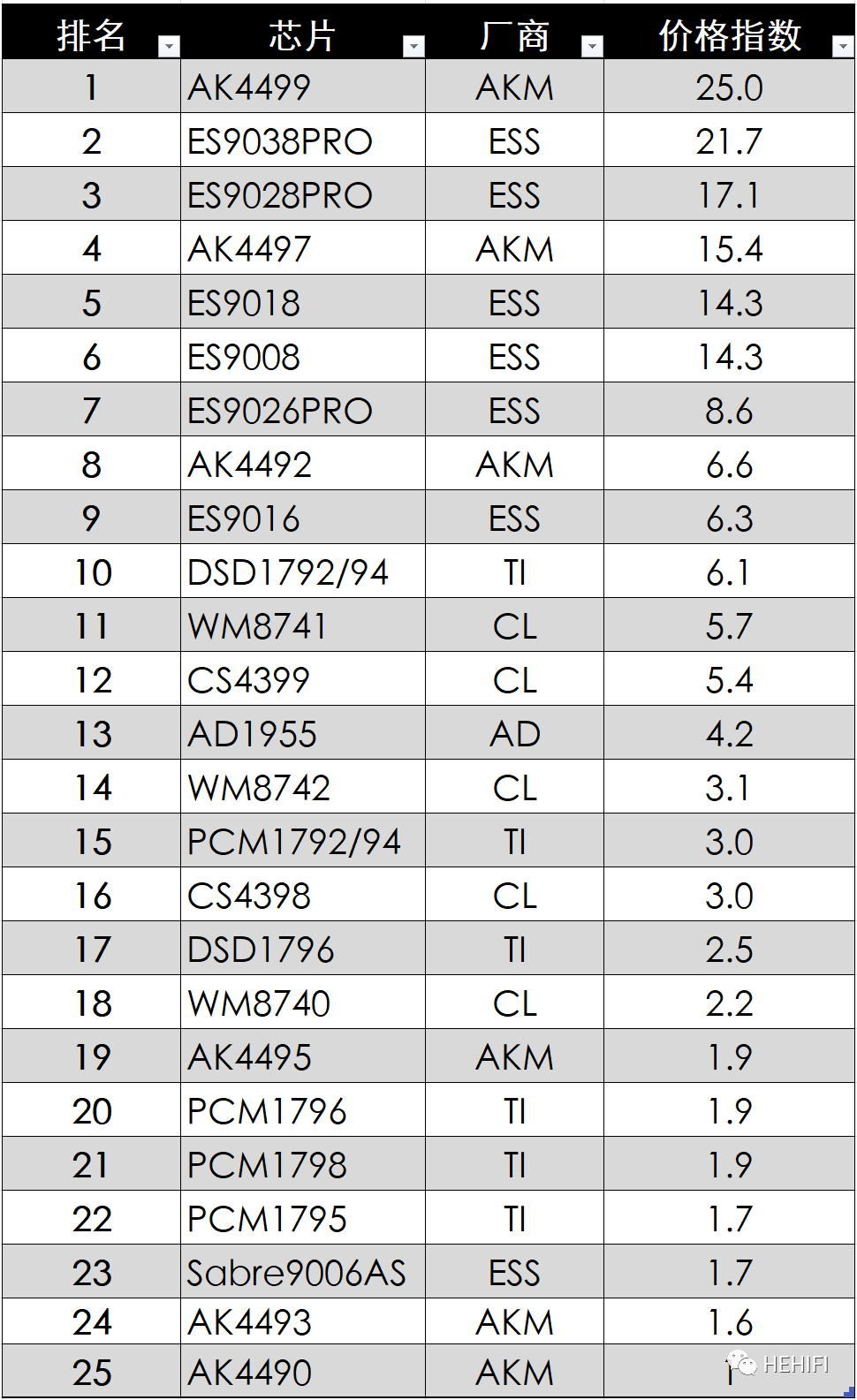
Note:The price index is obtained by dividing the sales price of each chip in the current official sales channel by dividing the lowest price.
Ranking by launch / launch time:
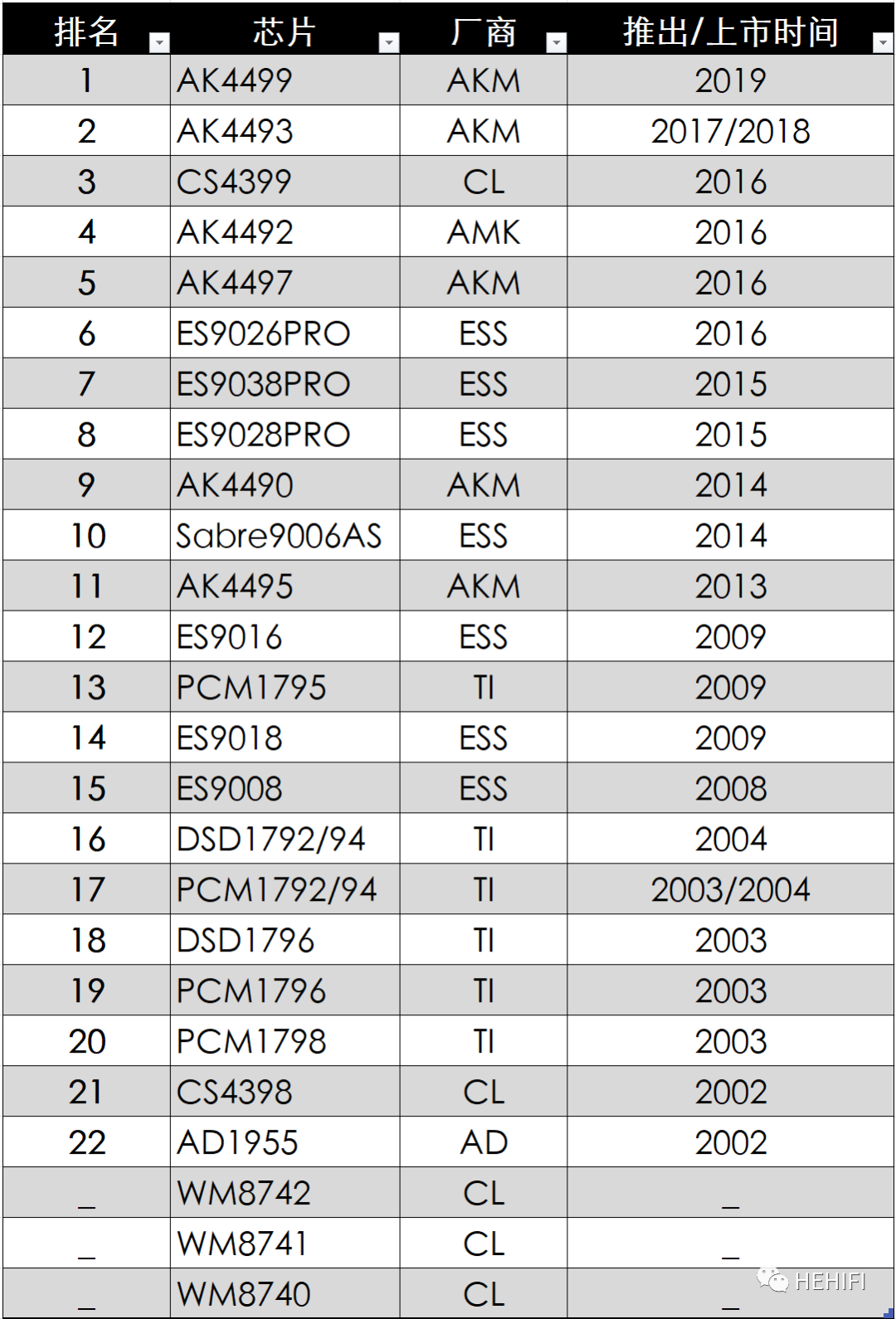
Note: according to each manufacturer'sOfficialCommercial documents and other official documentsThe information provided by the data as a time basis; a chip.The launch / launch date of the WM8740/41/42 is uncertain.
5
Summary
The chips of ESS and AKM are launched late and the technology is relatively new, so they have obvious advantages. Ranking is not the same as the pros and cons of sound, and everyone will have their own understanding and criteria for judging sound. Any good chip is likely to bring exciting sound; similarly, any good chip may not be able to perform as it should be due to the limitations of other parts in the whole machine, such as the dynamic range of 120dB, it is not easy for peripheral circuits to achieve this performance. High-end audio DAC decoding chip technology is complex, a wide variety, omissions and errors are inevitable, welcome to correct and supplement.
V2.0, March 2, 2021
Reference materials:
1.(C) The Data Conversion Handbook, ANALOG DEVICES, Walt Kester, Editor, ELSEVIER 2005;
two。Technical Details of the Sabre Audio DAC, Martin Mallinson and Dustin Forman, ESS Technology Technical Staff;
3.About Jitter:Digital Audio's weakest link, AMM ESS, October 2011;
4.TDA1541 Dual 16-bit DAC,Philips Semiconductors, November 1985;
5.TDA1541A Stereo high performance 16-bit DAC, Philips Semiconductors, February 1991
6.TDA1547 Dual top-performance bitstream DAC, Philips Semiconductors, September 1991
7.SAA7350 20-bit input bitstream conversion DAC for digital audio system,Philips Semiconductors, November 1991;
8.SABREES9008Reference 8-Channel Audio DAC Datasheet, ESSTECHNOLOGY,INC., February 18, 2015;
9.SABREES9016Ultra 32-bit 8-Channel AUdioDAC Datasheet, ESS TECHNOLOGY, INC., May 8,2015;
10.SABREES9018 Reference 32-bit AUdioDAC Datasheet, ESS TECHNOLOGY, INC., May 8,2015;
11.SABRE PROES9026PRO 32-BitHyperStream II 8-ChannelAUdioDAC, ESS TECHNOLOGY, INC., May 5,2019;
twelve。SABRE PRO ES9028PRO 32-BitHyperStream II 8-ChannelAUdioDAC, ESS TECHNOLOGY, INC., July 6,2020;
13.SABRE PRO ES9038PRO Flagship 32-BitHyperStream II 8-ChannelAUdioDAC, ESS TECHNOLOGY, INC., March 5,2019;
14.SABRE HIFI ES9038Q2M 32-BitStereo Low PowerAUdioDAC Datasheet, ESS TECHNOLOGY, INC., July 7,2019;
15.SABRE HIFI ES9080 32-BitHigh-Performance 8-ChannelDAC Prodcut Brief, ESS TECHNOLOGY, INC., Dec 1,2020;
16.SABRE HIFI ES9219 32-BitStereo Low PowerDAC with Headphone Amplifier, Analog Volume Control, and Output Switch, ESS TECHNOLOGY, INC., February 27,2020;
17. SABRE SABRE9006A Premier 8-Chnannel Audi DAC Datasheet,ESS TECHNOLOGY, INC., May 4,2020;
18.AK4495S/95Quality-oriented Premium 32-Bit 2ch DAC, AsahiKASEI, 2014/04;
19. = Preliminary = AK4191 Premium Digital delta Σ Modulator,AsahiKASEI, 2020/02
20. AK4377A Low-Power Advanced 32-bit DAC with HP,AsahiKASEI, 2018/02
21.AK4490EN Premium 32-Bit 2ch DAC, AsahiKASEI, 2015/12
twenty-two。AK4490 Premium 32-Bit 2ch DAC, AsahiKASEI, 2014/11;
23. AK4492 Quality Oriented 32-Bit 2ch DAC,AsahiKASEI, 2016/12;
24.AK4493 Quality Oriented 32-Bit 2ch DAC,AsahiKASEI, 2017/12;
25. AK4495S/95 Quality-oriented Premium 32-Bit 2ch DAC, AsahiKASEI, 2014/04;
twenty-six。AK4497 Quality Oriented 32-Bit 2ch DAC,AsahiKASEI, 2016/05;
twenty-seven。 AK4498 Quality Oriented Multi-bit Stereo DAC, AsahiKASEI, 2018/12;
twenty-eight。 AK4499 Premium Switched Resistor 4ch DAC, AsahiKASEI, 2019/02;
twenty-nine。CS4398 120 dB, 192 kHz Multi-Bit DAC with Volume Control, Cirrus Logic, Inc. July'05
30. CS4399 130-dB, 32-Bit High-Performance DAC, Cirrus Logic, Inc. Dec'16;
31. CS43131130-dB, 32-Bit High-Performance DAC with Integrated Headphone Driver and Impedance Detection, Cirrus Logic, Inc. Oct'17;
32. CS43198130-dB, 32-Bit High-Performance DAC with Pseudodifferential Outputs, Cirrus Logic, Inc. Oct'17;
33. WM 8740 24-bit, High Performance 192kHz Stereo DAC, WOLFSON MICROELECTRONICS LTD, July 2000;
34. WM 874124-bit 192kHz DAC with Advanced Digital Filtering, WOLFSON MICROELECTRONICS LTD, October 2007
35. WM 8742 24-bit 192kHz DAC with Advanced Digital Filtering, WOLFSON MICROELECTRONICS LTD, February 2013;
36. PCM63P Colinear ™20-Bit Monolithic Audio DIGITAL-TO-ANALOG CONVERTER,Burr-Brown Corporation, January, 1998;
37. PCM1702P PCM1702U BiCMOS Advanced Sign Magnitude 20-BitDIGITAL-TO-ANALOG CONVERTER, Burr-Brown Corporation, June, 1995;
38. PCM1704 24-Bit, 96kHz BiCMOS Sign-Magnitude DIGITAL-TO-ANALOG CONVERTER,Burr-Brown Corporation, February, 1999;
39. PCM1794A 24-BIT, 192-kHz SAMPLING, ADVANCED SEGMENT, AUDIO STEREO DIGITAL-TO-ANALOG CONVERTER, Texas Instruments, NOVEMBER 2006;
40. PCM1792A 24-BIT, 192-kHz SAMPLING, ADVANCED SEGMENT, AUDIO STEREO DIGITAL-TO-ANALOG CONVERTER, Texas Instruments, NOVEMBER 2006;
41. PCM1795 32-Bit, 192-kHz Sampling, Advanced Segment, Stereo Audio Digital-to-Analog Converter,Texas Instruments, MARCH 2015
42. PCM1796 24-BIT, 192-kHz SAMPLING, ADVANCED SEGMENT, AUDIO STEREO DIGITAL-TO-ANALOG CONVERTER, Texas Instruments, NOVEMBER 2006;
forty-three。(C)PCM1798 24-Bit, 192-kHz Sampling, Advanced Segment, Audio Stereo Digital-to-Analog Converter,Texas Instruments, MARCH 2015
44. DSD1792A 24-BIT, 192-kHz SAMPLING, ADVANCED SEGMENT, AUDIO STEREO DIGITAL-TO-ANALOG CONVERTER, Texas Instruments, NOVEMBER 2006;
forty-five。 DSD1794A 24-BIT, 192-kHz SAMPLING, ADVANCED SEGMENT, AUDIO STEREO DIGITAL-TO-ANALOG CONVERTER, Texas Instruments, NOVEMBER 2006;
forty-six。 DSD1796 24-BIT, 192-kHz SAMPLING, ADVANCED SEGMENT, AUDIO STEREO DIGITAL-TO-ANALOG CONVERTER, Texas Instruments, NOVEMBER 2006;
47. AD1955High Performance Multibit Σ-ΔDACwith SACD Playback, Analog Devices, Inc., 2002;
48. CS8416, 192kHz Digital Audio Interface Receiver, Cirrus Logic, AUGUST '07.
(End)


